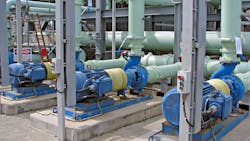Where pump optimization meets energy efficiency
The word “optimization” can have various meanings and interpretations, but the benefits of optimization are straightforward: improve profitability while maintaining the same utility. Reliability has long been the larger focus of this equation, but the cost-savings potential in minimizing energy usage is emerging as a critical factor, with the Hydraulic Institute (HI) defining pump system optimization as follows:
The process of identifying, understanding and cost-effectively eliminating unnecessary losses while reducing energy consumption and improving reliability in pumping systems, while meeting process requirements, minimizes the cost of ownership over the economic life of the pumping systems.
Seeing the bigger picture
The U.S. Department of Energy’s 2002 Motor Market Assessment established that pumping systems offer the greatest optimization potential of all types of fluid systems, offering savings up to 75%, with an average net savings of 20.1%. Consistent with this research, HI presents the complete picture of opportunities for optimization including the important energy efficiency opportunity.
Of course, maintaining that balance and correlation between spend and output is essential — either a reduction in spend or increase in output boosts optimization. However, if the pump system can minimize utility costs via reduced consumption of water and energy in a way that does not compromise reliability or output, optimization is achieved.
Additionally, power utilities may incentivize system optimization by subsidizing assessment costs and providing rebates that cover a portion of the new energy savings upgrade. In fact, HI recently launched digital resources to assist utilities in establishing and maintaining incentive programs to assist in overall energy reduction.
Building the best assessment
To achieve peak optimization in a pump system, it is important to start with an assessment. Proper assessments provide a host of results to justify costs for improvements to the system’s design, control, operation and maintenance. Improvements to pump systems for ultimate optimization can result in reduced system head (pressure), reduced system flow rate or operating time, more efficient equipment or controls, and/or improved maintenance or operation procedures.
When evaluating a pump system, there are various levels of assessment.
The paper audit is a level one assessment that begins with a pre-screening and gathering system information for pumping systems. This data draws from equipment information, control schemes, operating parameters, reliability issues and performance curves. With this information, potential for energy savings can be quantified, and recommendations for level two or level three assessments can be made.
Level two assessments entail physically measuring the system for a specific amount of time in order to provide a snapshot of how the system is operating. It is important to note, however, that a level two assessment will not be sufficient for systems with significant variable flow or pressure over time.
A level three assessment is a longer-term system measurement performed to establish how the system operates over a period of time. This assessment documents how the system varies so that the complete picture can be seen. This type of assessment is accomplished with the use of in-situ monitoring combined with any available historical site data.
Building an assessment team
It is also important to understand that collaboration is essential when undergoing pump system evaluations and assessments. Because of the complexity of such systems, the assessment team should be comprised of personnel from cross-functional backgrounds including:
- A host organization representative that has management support and overall responsibility and ownership
- Assessment engineer with broad pump system analysis competencies
- Specialists on system processes, operations and functions
- Specialists on the maintenance practices and history
- Specialists who can provide the team with cost data
There are certified professionals who can assist with this, known as Pump Systems Assessment Professionals. These experts have completed HI’s PSAP program, a certification program that sets the standard for the discipline of pump systems assessment and the use of pump system optimization techniques. Professionals with the PSAP certification have demonstrated that they have the requisite knowledge and experience to perform high quality pump system assessments.
Pump system assessments are the path to optimizing a system and gaining an average of 20% in energy savings. Do not become overwhelmed by the prospect and utilize certified professionals to support your efforts. Extensive resources are also available through HI to optimize pump systems as well as find certified PSAPs and related certificate information.
Peter Gaydon is director, technical affairs for the Hydraulic Institute. The Hydraulic Institute (HI) centers the pump industry around excellence and efficiency to power everyday life. HI’s mission is to advance the pump manufacturing industry by becoming the world’s resource for pumping solutions and advancements in the industry by: addressing pump systems, developing standards, expanding knowledge and resources, educating the marketplace and advocating for the industry.
About the Author
Peter Gaydon
Director, Technical Affairs for the Hydraulic Institute
Peter Gaydon is the Director, Technical Affairs for the Hydraulic Institute. The Hydraulic Institute (HI) centers the pump industry around excellence and efficiency to power everyday life. HI’s mission is to advance the pump manufacturing industry by becoming the world’s resource for pumping solutions and advancements in the industry by: Addressing Pump Systems, Developing Standards, Expanding Knowledge and Resources, Educating the Marketplace and Advocating for the Industry.
